These rules are adapted to playing at Yucata. You can find the original rules
on the author's web page.
Components
- A playing board, divided into 64 squares in eight different colours.
- 16 dragon towers, eight for black and eight for white.
This is the initial setup. You are playing white from the bottom to the top. Your opponent is playing black from
top down to your baseline. There are four different board layouts. One of them is randomly chosen at the beginning of the game.
Each tower wears the Chinese character of its colour: Brown, Green, Red, Yellow, Pink, Purple, Blue and Orange. The
towers are placed in the players' 'home row', yours at the bottom, your opponent's at the top. Each tower is placed on
the square that matches its color. So the brown tower is placed on the brown square and so on.
 |
Your opponent's 'home row' |
| Your 'home row' |
The player with fewer number of scored Kamisado games begins.
Object of the game
The game is played in rounds. Within each round, the object is to reach your
opponent's 'home row' with one of your dragon towers. The tower that manages to do this first, gets promoted to a 'Sumo'
dragon tower and is worth one point to its owner. In later rounds the 'Sumo' can became a 'Double' or 'Triple Sumo'
worth 3 and 7 points. A 'Triple Sumo' that gets promoted again will score 15 points.
The game is offered in the following variants:
- Single Round: where the first player to score 1 point is the winner.
- Standard Match: where the first player to score a total of 3 points is the winner.
- Long Match: where the first player to score a total of 7 points is the winner.
- Marathon Match: where the first player to score a total of 15 points is the winner.
Playing the game
During each round, the players take turns to move a dragon tower, each attempting to be the first to place a
dragon tower on a square within their opponent’s home row.
The dragon towers are moved according this rules.
WHICH TOWER?
2 Rules determine, which tower a player moves:
On Yucata, the tower that you have to move and the squares it can be moved to are highlighted.
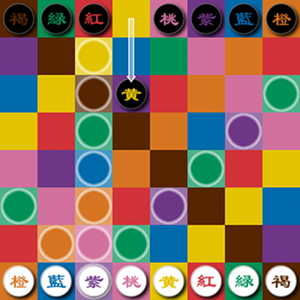 |
Your opponent has started by moving the Yellow tower
to a Purple square. Therefore you have to move your Purple tower to one of the squares marked with a circle. |
VALID MOVES?
Rules determining how that tower can be moved:
- Rule M1: A tower must be moved in a straight line, either directly forwards or diagonally forwards. No
sideways or backwards moves are EVER allowed, except backwards moves made as a result of a ‘Sumo push’.
- Rule M2: A tower can be moved any number of squares, but may not pass through any square that already
contains a tower (either belonging to the player making the move, or to the opponent). A tower can even be moved
directly from a square in a player’s own home row to an empty space in the opponent’s home row, provided that this
move is in a straight line and there are no towers on any of the squares the tower has to pass through.
- Rule M3: A tower can only be moved to a square that was previously empty (i.e. no two towers may ever
occupy the same space).
- Rule M4: A tower is allowed to move diagonally between two dragon towers that occupy squares that touch
corner-to-corner.
- Rule M5: A tower must be moved at least one square if it is at all possible to do so.
- Rule M6: If it is impossible to move the required tower in any way (i.e. if it is
completely blocked from moving forwards or diagonally forwards), the player whose turn it is to move that tower has to
miss that turn, and the opponent moves again immediately. (see What
Happens if your Tower is Blocked?).
- Rule M7: The round finishes as soon as either player succeeds in moving one tower to any square within
their opponent’s ‘home row’. That player has now ‘won’ that round.
- Rule M8: It is possible, although extremely unlikely, to get a situation where both
players have towers which are completely blocked so that they cannot be moved, and for these towers to interact to form
a ‘deadlock’ situation where no further towers can be moved at all. In this situation, the player who made the last
move prior to the occurrence of the deadlock situation (i.e. the player who ‘caused’ the deadlock) is considered to
have lost the round, and their opponent is the winner of that round.
A player who finds that the tower they are supposed to be moving is completely blocked (i.e. this tower cannot
be moved at all, either forwards or diagonally forwards) must forfeit their turn (Rule M6). Although
the tower remains on the same spot, it is considered that this dragon tower has made a (zero-length) move that
finished on this square. This means that this player’s opponent will move again, using the tower whose colour matches
the square on which the blocked player’s dragon tower was trapped.
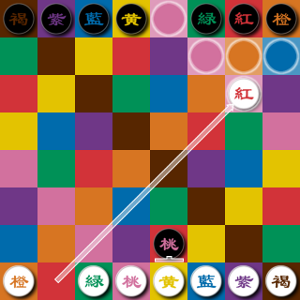 |
You moved the Red tower to a Pink square. Your opponent's Pink tower
can not move and because it stands on a Red square, you can move your Red tower again and win the round. |
Deadlock!
It is possible to get situations where neither player can move any towers in a sequence of moves that
repeat indefinitely (Rule M8). These are known as ‘Deadlock’ situations. When a
deadlock situation occurs, the last person to move a tower before the deadlock occurs loses that round! (i.e. the last
player to have moved is adjudged to have ‘caused’ the deadlock – even if they were forced to do so). Deadlock situations
are extremely rare, partly because players are careful not to cause them. They can involve a ‘perpetually repeating
sequence’ of two dragon towers (one belonging to each player), or four towers, or six, or more.
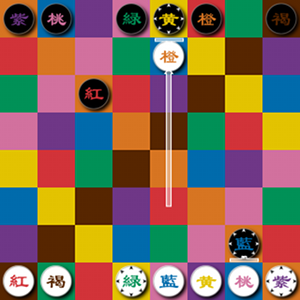 |
You have moved your Orange tower onto the
Blue square. Your opponent's Blue tower is blocked.
Because it stands on a Orange square, you have to move with your Orange tower again.
But it is blocked too. You were the last player who made a move, therefore your opponent wins the round and their Blue
tower turns into a 'Sumo'. |
End of a round
A ‘Sumo’ is Born!
The dragon tower that went through to a square on the opponent’s ‘home row’ gets promoted. This tower is now known as a
‘Sumo’ dragon tower. If the previous round ended in a ‘deadlock’ situation, then the player who did not
cause the deadlock promotes their tower that matches the colour of the square that their opponent last moved to.
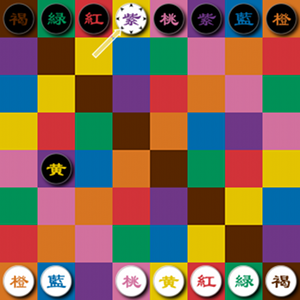 |
Your Purple tower has reached the top row and is now
a 'Sumo'. You have won this round and one point. |
If the tower was already a 'Sumo' it gets promoted to a 'Double Sumo', a 'Double Sumo' becomes a 'Triple Sumo' and a
'Triple Sumo' turns into the ultimative 'Quadruple Sumo'.
'Sumo' towers are restricted in terms of the number of spaces they can move, but they have special powers that allow
them to make a move called a ‘Sumo Push’. Both these aspects of Sumo towers are discussed in the section
Sumo powers and restrictions
.
The Dragon Towers Regroup!
The towers are returned to each player’s home row, ready for the next round. The order in which the towers are lined up
for this new round is determined by the player who won the previous round, who can now choose to “fill from the left” or
“fill from the right”.
FILLING YOUR HOME ROW
Rules governing filling from left or right:
- Rule F1: The player who won the previous round (the Defender in the new round) chooses whether to fill
from the left or from the right.
- Rule F2: The player who lost the previous round (the Challenger in this new round) is then obliged to
fill in the same direction as the Defender.
- Rule F3: If the Defender chooses to fill from the left, each player (Defender first, followed by
Challenger) selects one tower at a time in an order determined by the row each tower is in and the position of each
tower within each row, and places each in turn on the squares within their home row, starting with the brown square on
the left-hand side, and working across to the orange square on the right-hand side.
- Rule F4: If the Defender chooses to fill from the right, each player (Defender first, followed by
Challenger) selects one tower at a time in an order determined by the row each tower is in and the position of each
tower within each row, and places each in turn on the squares within their home row, starting with the orange square
on the right-hand side, and working across to the brown square on the left-hand side.
Here at Yucata, the computer takes over this tedious work of collecting the towers and filling the home rows the
correct way. The choice of filling from the left or right gives the Defender two set-up options. This helps them to
avoid weak positions that the Challenger can attack easily.
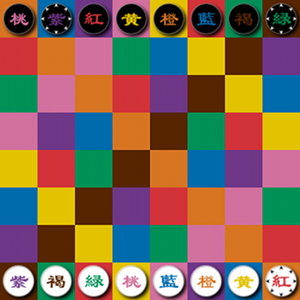 |
Here is an example of a very bad set-up, where your opponent wins the next round for sure. |
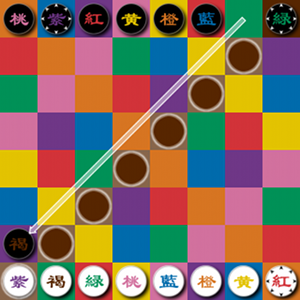 |
Your opponent moves their Brown tower onto the Purple square. |
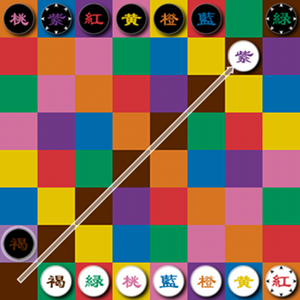 |
Your Purple tower can only move onto Brown squares. |
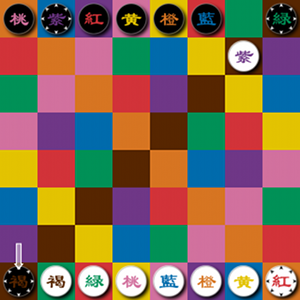 |
And that is already the end of this very short round. |
Sumo towers are stronger but slower than lower ranked towers. Therefore they can not move as far but they can perform a Sumo-Push against lower ranked towers to push them back.
A 'Sumo' can push a normal dragon tower, a 'Double Sumo' up to two normal and 'Sumo' towers, a 'Triple Sumo' up to three normal, 'Sumo' and 'Double Sumo' towers.
After a Sumo push you can move again with the dragon tower whose colour matches the square on which the last tower that was pushed now stays.
|
| Sumo |  |
|
| Double Sumo |  |
|
| Triple Sumo |  |
|
| Quadruple Sumo |  |
|
| Movement range |
5 |
3 |
1 |
- |
Number of towers that can be
pushed with a Sumo push |
1 |
2 |
3 |
- |
| Points |
1 |
3 |
7 |
15 |
Rules applying to sumo dragon towers:
- Rule S1: A 'Sumo' tower is stronger, but slower than a normal dragon tower. It may be moved up to a
maximum of 5 spaces. A 'Double Sumo' may move up to 3 and a 'Triple Sumo' only one space.
- Rule S2: Because a Sumo tower is stronger than a tower with a lower rank, it may perform a move called a ‘Sumo push’ on opponent’s lower ranked towers.
For this to happen, the opponent’s towers must be on the square immediately in front of the
Sumo tower, and the opponent must have ended the previous move on a square whose colour matches the colour of the
Sumo tower. When this happens, the player has the option of using a Sumo push on the opponent’s towers. This means that
the Sumo tower will move one space forwards, pushing the opponent’s towers one square backwards as it goes.
- Rule S3: Immediately after the Sumo push, the opponent skips their turn, and the original player (i.e. the one who made the
Sumo push) moves again straight away, using the dragon tower whose colour matches the empty square that was behind the pushed towers.
- Rule S4: A Sumo push cannot be made diagonally. The pushed pieces must be on the squares immediately in
front of the Sumo, when the push occurs.
- Rule S5: There must be an empty square ‘behind’
the pushed piece for this piece to be pushed into. The colour of this square determines what colour tower the player
moves next, after the opponent has forfeited their next turn.
- Rule S6: Sumos cannot push a piece if that piece is
on its own home row (i.e. it cannot push a piece ‘off the board’).
- Rule S7: A 'Sumo' cannot push more than one, a 'Double Sumo' not more than two and a 'Triple Sumo' not more than three pieces backwards at the same time.
- Rule S8: A Sumo cannot push another Sumo that has the same or a higher rank.
- Rule S9: A player can only perform Sumo pushes on
their opponent’s pieces, not their own.
- Rule S10: A Sumo push is an option that the player is not obliged to use, if
there are alternative diagonally forward moves that bypass the piece which could be pushed.
- Rule S11: However, if the
Sumo push is the only move available with the tower concerned, then the player is forced to make the Sumo push (i.e.
the player is not allowed to ‘pass’ on their move and do nothing if a Sumo push is an available option). If this
happens, the player must play the Sumo push move, and is not allowed to do nothing on that turn.
Examples of a Sumo push:
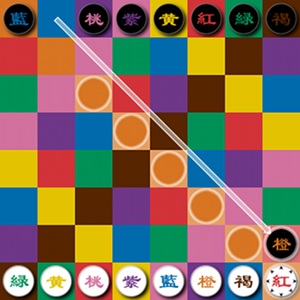 |
Your opponent moves onto the Red square in front of your
Red Sumo. |
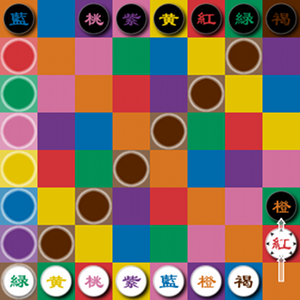 |
The Sumo-push moves your opponent's tower onto a Green
square. You can move again with your Green tower. |
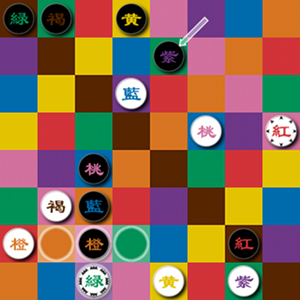 |
Your Green 'Triple Sumo' can perform a Sumo push on three towers. |
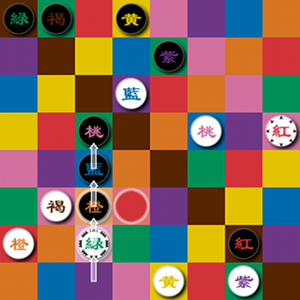 |
Because the last tower gets pushed onto a Green
square, you can move again with your Green 'Triple Sumo'.
If you would perform another Sumo push, you'll have another move with your Brown
tower. |
End of game
The game ends as soon one player has the required points.